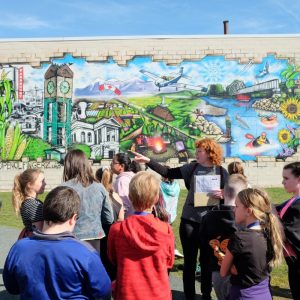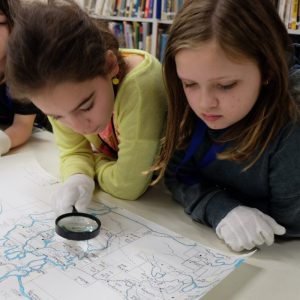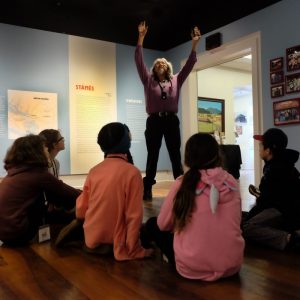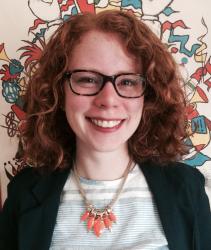Guest blog by Lena Yacyshen, Classroom-in-Residence Coordinator
In December we posted a blog about a new education project we would be launching in the spring. Now that the Classroom in Residence pilot project has wrapped up, we can share a little more about our experience and the activities students participated in during their museum residency.

Students learning about Chilliwack’s historic downtown and making comparisons between the old and new architecture.
The Classroom in Residence Project is different from other museum education programs in that it is week-long and immerses students in the museum, Chilliwack’s history and community. We hosted two elementary school classes during the pilot project. The students learned a lot and made strong connections throughout the week, and we also learned a lot from them too. These two pilot classes have helped lay the foundation for the project moving forward and have also demonstrated the value of the project to School District #33.
Each day students participated in different activities in the community and at the museum. In the afternoon students were given time to slow down and reflect on the mornings events in personal journals. This kind of open ended assignment not only helps build students’ critical thinking, writing and drawing skills but also allows them to document their learning in a personal way. This balance of learning new things, (and having new experiences) making connections with what has been learned in the classroom while taking time to slow down, reflect and consolidate learning is an essential aspect of the project.
What did the week look like?
Day One: Students were given an extensive museum tour and shown around Chilliwack’s Historic Downtown.
Day Two: Students spent the morning at the archives learning about how material culture informs us about time, place and culture and the importance of preserving and having access to local documents. Students also used primary sources to examine land settlement over time in Chilliwack and learned how to conduct basic local research.

Students using primary sources to look at land settlement and development over time in Chilliwack.
Day Three: Guest speakers from Stó:lō Nation and Sq’éwlets Fist Nation discussed the current exhibit and other aspects of Stó:lō culture and history such as transformation/ origin stories and the impact of residential schools. In the afternoon students visited the library for a tour and an introduction to all the activities and learning resources available at no cost.
Day Four: Students were given a behind the scenes tour of The Chilliwack Progress’ newsroom and learned about local news from their award-winning journalists. Later, students created their own group newspaper, basing production on what the Progress’ team taught them.
Day Five: Museum staff gave a lesson on exhibit creation/design and students mocked up their own exhibits for the museum. Students finalize their best journal entry from the week and installed their own exhibit out of their entries (come by the museum before June to see it!). That afternoon, students hosted an open house for their parents and School District staff where they gave museum tours and showcased what they had been learning throughout the week.
Lessons Learned

Students captivated by (Albert) Sonny McHalsie’s story telling.
At the end of the week students were excited about all the new discoveries and connections they made in their hometown, and they wished the residency could have lasted longer. Students came away with a strong sense of place and a deeper understanding of many topics because of their unique experiences. Learning first hand from important Stó:lō community members and Elders allowed students to truly understand the hardships this community has faced, but has also given them a sense of the beauty and strength of Stó:lō culture. Learning behind the scenes at the library and newspaper gave students insight into how these institutions meet the needs of our community and contribute to our sense of place. Learning about Chilliwack’s past and present helped participants feel connected and more invested in our community. Program participants could see the museum (and all museums) as a place for living culture where there are links between the past and our contemporary environment. These collective experiences instill curiosity and a love of learning and we feel strongly that the students we have worked with will become life-long learners who are invested in their community.
A word from the Coordinator
My time at the museum as Classroom in Residence Coordinator has whizzed past me because of the fun, challenging and dynamic nature of the position. Everyday I learned multiple new things about myself, Chilliwack’s history and community, education, museum practices and more. I have been interested in pursuing a career in education outside of the traditional classroom, being unsure of what form that would take this type of local and collaborative approach to education has been eye opening for me. I can’t wait to see how the Classroom in Residence Project evolves over time- the possibilities are endless and the students that get to participate are truly lucky.


Comments are closed.